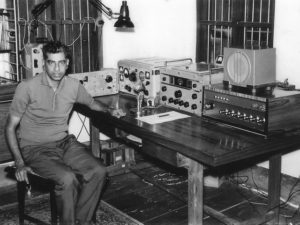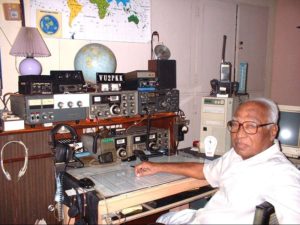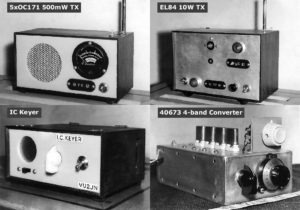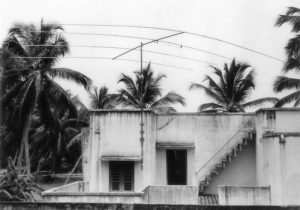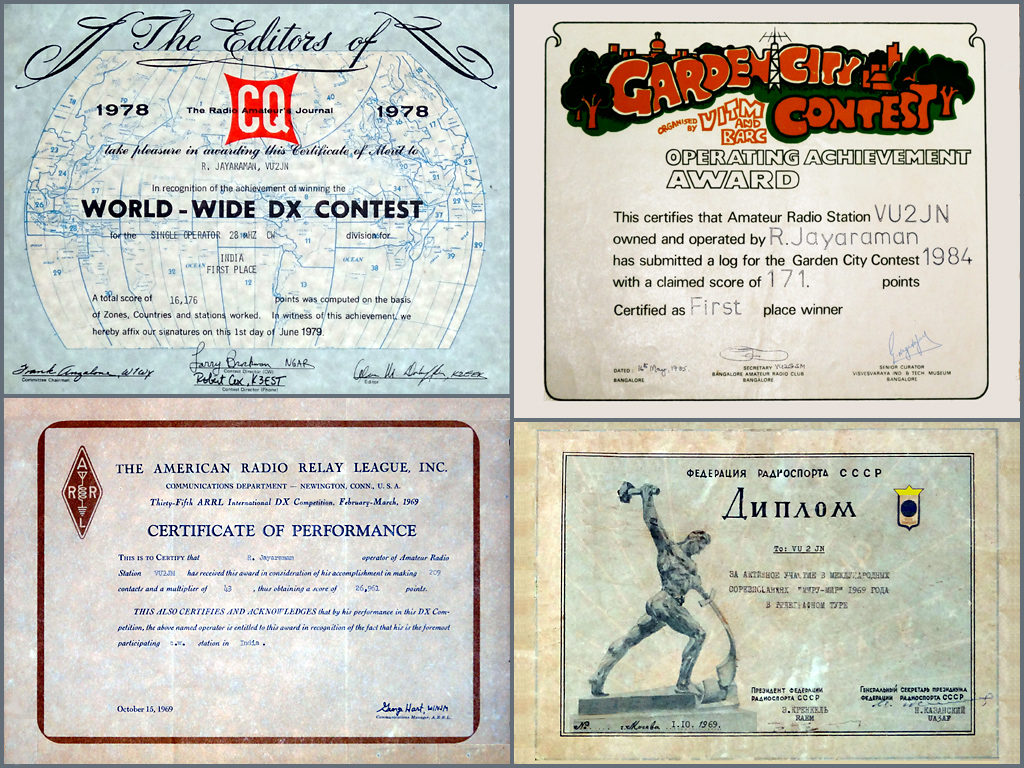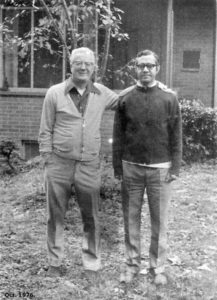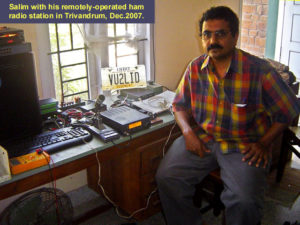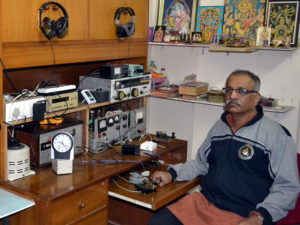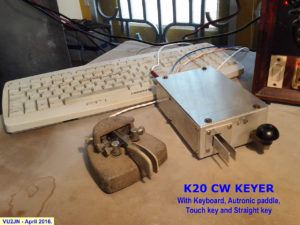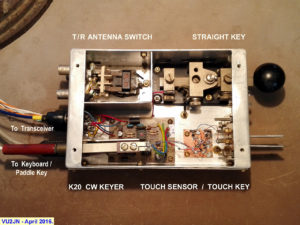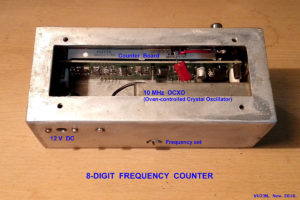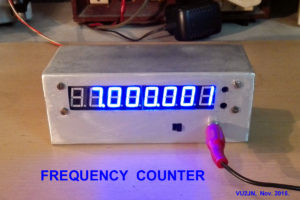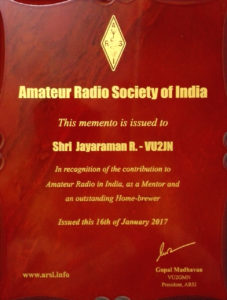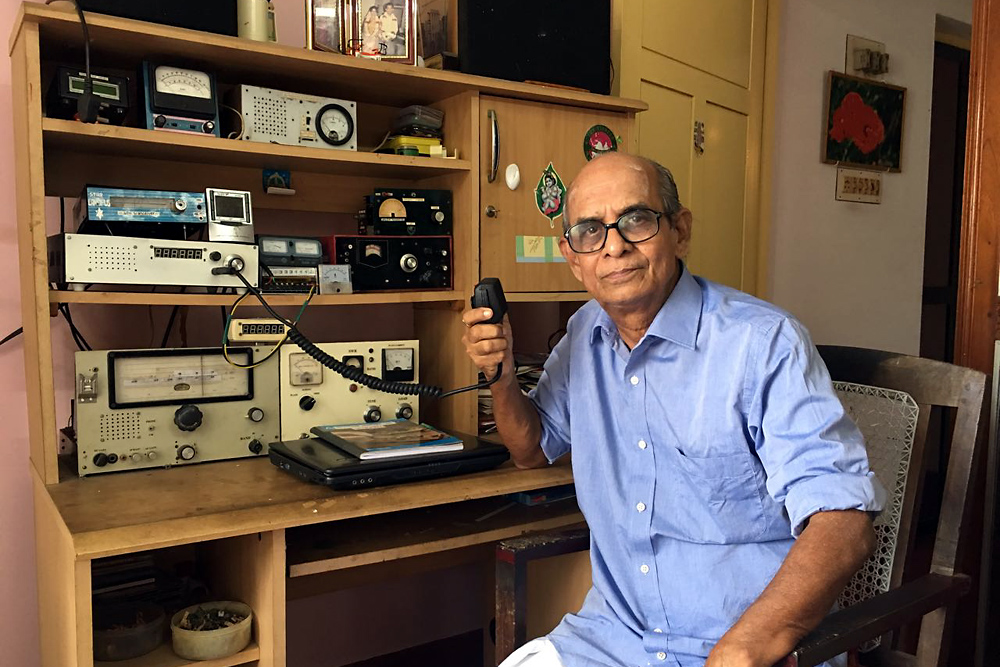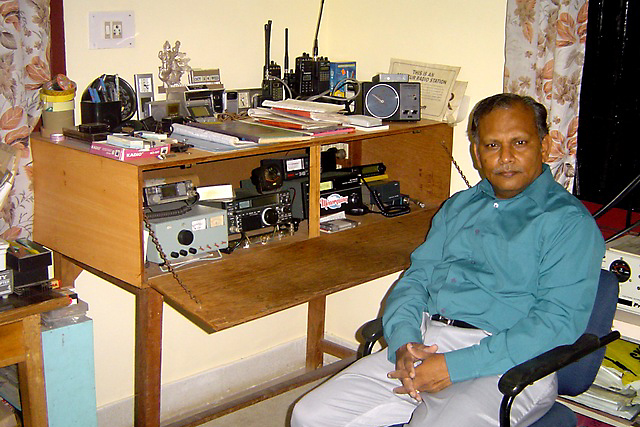As a youngster, I took interest in many hobbies, but none became as overwhelming as Amateur Radio which, to use a poet’s phrase, “had me in thrall!”
Dawn of the Transistor Age:
Till my graduation, I had very little exposure to electronics. It was in the year 1956, just after my graduation, that an article on Transistors caught my attention, and left me itching to build a simple radio employing the tiny ‘wonder device’. Flush with the desire to learn ‘electronics homebrewing’, i.e. assembling electronic equipment at home, I started reading about and understanding electronic circuits, especially transistor circuits.
Early in the year 1957, there appeared a Phillips advertisement in the local newspapers announcing the availability of the first-generation transistors in India. The Phillips dealer in Trivandrum was begged and coaxed to order and get me a few pieces of OC-71 and OC-72 transistors. A MW (Medium-wave) crystal radio with a 4-transistor audio amplifier, as described in the Phillips handout, was assembled. It was my first venture with the soldering iron! The squeaky sound from the loudspeaker of the battery-powered single-board radio left me greatly thrilled.
In 1961, a 2-band transistor superregenerator receiver was built by me using the new ‘surface-barrier transistor’ SB100 which had appeared in the US market. Two pieces of SB-100 were obtained from an obliging US dealer by sending IRC’s (International Reply Coupons) — in those days, a cumbersome procedure was necessary to import even small items against Rupee payment. SB-100 was a delicate transistor having a peak voltage rating of 4.5V, collector dissipation of just 10mW and cutoff frequency of 45MHz. The superregenerator worked fairly well, but was no match for superheterodyne receivers employing the OC-171 transistors that appeared soon in the Indian market.
Entry into Hamdom:
Around this time, I got attracted to Amateur Radio — the unique hobby that enables a licensed radio amateur, often referred to as a ham, to set up an amateur wireless station and to have wireless contacts in authorized amateur frequency bands with similar stations located elsewhere in the world . The contact could be made in any one of several modes of operation such as CW (Morse code), AM (Amplitude-modulation voice), SSB (Single-sideband voice), FM (Frequency-modulation voice), etc. Amateur Radio has the distinction of being referred to both appreciatively as the King of Hobbies, and derisively as the Hobby of Kings!
I appeared for the ASOC (Amateur Wireless Station Operator’s Certificate) test conducted by the WPC (Wireless Planning and Coordination Wing, Department of Telecommunications, Government of India), and qualified for the Amateur Wireless Station License No. 319/ 1964, authorizing my call-sign VU2JN.
Setting up my Amateur Radio station:
I first came on the air using a homebrew VFO (variable frequency oscillator) plus 1625 valve CW/AM transmitter running 50 watts power. The receiver was an old Hallicrafters S40A. The antenna was a multiband dipole.
Propagation conditions were good in 1964, even though the period was not close to sunspot maximum. 1958 was an all-time peak with a sunspot number of 255. I missed it, but our late ham friend Karan (VU2BY) — the seniormost ham of Kerala, and uncle of Gopal (VU2GMN), President of the ARSI (Amateur Radio Society of India) — who was living in Trivandrum at that time, used to tell us about his working US stations using an AM transmitter running 25 watts! VU2BY and VU2GMN can be seen in two group photos appearing on this page. Another ham in Trivandrum succeeded in contacting US stations using a 6V6 valve CW transmitter running 10 watts!
In 1968, I built a CW/AM transmitter employing 3 Nos. of 1625 transmitting valves in the PA (power amplifier), running 150 watts, and driven by a 1614 metal valve. It can be seen in the shack photo appended below. This transmitter served me well for more than three decades.
The sunspot peak of 1970 was somewhat inferior to that of 1958 but was still good, and the excellent band conditions permitted me to reap a rich harvest of DX (long-distance) contacts on 40, 20, 15 and 10-metre CW.
Homage to my senior Ham friends:
I cherish the early QSOs that I had on 40 metres with senior hams like Neel (VU2LN) and Kuki (VU2VK) in Trivandrum, Hari (VU2TH) in Kochi, Vasan (VU2NS) in Salem, Swamy (VU2TX) in Udumalpet, Venkat (VU2SV) and Ranga (VU2GW) in Chennai, and Bala (VU2LE) in Karaikudi.
Neel and Kuki came on the air in 1962 and, being local hams, became my family friends. Neel was a witty person and a brilliant engineer of Kerala State Electricity Board. I used to go to him for clearing my technical doubts. Here I must mention a ‘golden quote’ of Neel. After getting disenchanted with the working of ham clubs in India, Neel declared, “Hams should meet only on the air!” He passed away in 2007, aged 80 years. Kuki, a doctor by profession, is now settled in Bangalore, and is using the tube-type receiver and transmitter that he assembled while living in Trivandrum. Hari (VU2TH), who was a scientist in a national laboratory and a guiding ham of Kochi, is also a family friend of mine. Settled near Coimbatore, he is not an active ham now.
Vasan was a retired principal of a Salem college who strongly believed in simple equipment and helped many SWLs in and around Salem to become hams. The transmitter that he first assembled had no chassis, and was wired on a wooden board! He passed away in 1991. Swamy, an agriculturist of Erisinampatti near Udumalpet, was a self-taught experimenter and a much-loved senior ham. He passed away in 2012. Ranga and Bala belonged to an elite group of CW DXers. After building my CW Keyer, I enjoyed having high-speed CW QSOs with them. I have also had the pleasure of meeting them. Sadly, they are no more with us. I recall with pleasure my visits to the homes of Vasan, Swamy, Ranga and Bala.
A few other departed hams who became my family friends in the nineteen sixties and seventies were: Guhan (VU2TG) in Kottayam, Raj (VU2HY) in Nagercoil and, Das (VU2CSD) and Kutty (VU2PKK) in Trivandrum.
Guhan, who was an electrical engineer like Neel, was an expert on hi-fi systems, and had a superb hi-fi setup in his house employing a 15-pound gyro-controlled turntable having a costly Sorensen pick-up, hi-fi valve amplifiers and big speaker systems with a flat response down to an inaudible 15 Hz (however we could feel the 15 Hz output by the tingling of our skin!). After becoming a ham, Guhan built a superb 150-watt plate-modulated transmitter which used to put out a broadcast-quality 40-metre AM signal that was heard all over South India, even in simple transistor radios. My 3×1625 PA employing a carefully-designed screen modulator with carrier control came close to Guhan’s rig in quality and punch, but couldn’t equal it, proving that plate modulation is unbeatable! Quite a few hams have told me that, as SWLs and budding hams, they used to enjoy listening to the ‘technical QSOs’ between Guhan and myself. Sadly, Guhan passed away in 2000, aged 75 years.
Das was a businessman by profession, and an active ham of Trivandrum. He passed away in 1995 at the young age of 49 years. Raj was an agricultural scientist, and a good homebrewer of Nagercoil. He passed away in 2011, aged 78 years.
Kutty, who was an engineer employed in a central government service, became a ham with call-sign VU2PKK in the early nineteen seventies. Later he joined Thumba Equatorial Rocket Launching Station near Trivandrum. He was age-wise my senior, and lived just about 3 km away from my home. We became family friends, and exchanged frequent visits. Kutty was a very active ham and, powered by his FL-2100Z linear amplifier and Mosley triband beam antenna, he became one of the most active DX hunters in India. Sadly, Kutty passed away in 2012, aged 84 years.
My very first QSO (radio contact) was with Venkat (VU2SV) on 40 metres in 1964. Venkat is a gifted homebrewer whose chassis work and construction have always been superb. I made two visits to his home in Chennai in the nineteen sixties. Even now, we meet whenever I visit Chennai. Venkat is 2 years older to me. He is not an active ham now.
Homebrewing and Authoring:
Homebrewing always held an attraction for me. My first significant transistor homebrew project, implemented in 1966, was a 500 mW CW/AM Transistor Transmitter employing 5 Nos. of OC-171 in the PA. In those days, only low-level germanium transistors were available for high-frequency applications. This transmitter performed so well that I was able to make phone contacts with all active South Indian and Sri Lankan hams on 40 metres. Articles describing this rig appeared in The Indian Radio Amateur of Dec.1966, and subsequently in the US magazine QST of Nov.1967.
In 1969, I assembled an IC Keyer which was the first such keyer to be assembled by a VU ham. An article describing this appeared in The Indian Radio Amateur of Feb.1970. This keyer was regularly used by me till recently.
The first dual-gate MOSFET 40673 was released by RCA in Aug.1969. A US ham friend of mine, who received an ‘experimenter’s sample’ from RCA, was kind enough to pass it on to me by air. I set about working on it and, within a month, assembled a 4-band Crystal-controlled Converter employing 3 FETs — a 40673 mixer, a 3N128 Q-multiplier and a 2N3819 crystal oscillator. Its performance was remarkable. With a low-level pure crystal oscillator as the LO at the front-end, it actually showed a better noise figure than Yaesu FT-747GX transceiver. I believe that the concept of using a pure crystal oscillator as the first LO in a ham-band receiver has not been exploited fully by VU hams. My article “A Deluxe 40673 Converter” describing this converter appeared in the Feb.1970 issue of CQ magazine, and brought me letters of appreciation from US hams.
After 1971, the demands of my profession restricted my hamming and homebrewing activities. However, I continued to take up small projects such as Crystal Oscillator, Gigaohm Tester, RF Probe, Transistor Tester, FET Millivoltmeter, 50-ohm Dummy Load, etc. The Crystal oscillator shown in the figure appended below has no tuned circuit, and employs a 2N3819 JFET oscillator followed by a 2N3796 MOSFET source-follower, giving about 1-volt low-impedance output. The RF probe employs a single 1N270 high-conductance diode and a miniature choke, instead of the more common two-diode configuration. An article on the Gigaohm tester is appended to this page.
Apart from the articles in The Indian Radio Amateur, 10 articles of mine have appeared in the US ham magazines QST, CQ and 73. Most of these articles are linked at the end of this page. Some are available online at the web-sites of Salim (VU2LID), and Sunil (VU2SWX).
My circuit in the Big Book!
After becoming a ham, I had occasions to browse through in our college library what we called the ‘Big Book’ — Electronic Circuits Manual published by McGraw-Hill of USA, and revised periodically by John Markus. But I had no inkling then that my circuit would find a place in the Big Book.
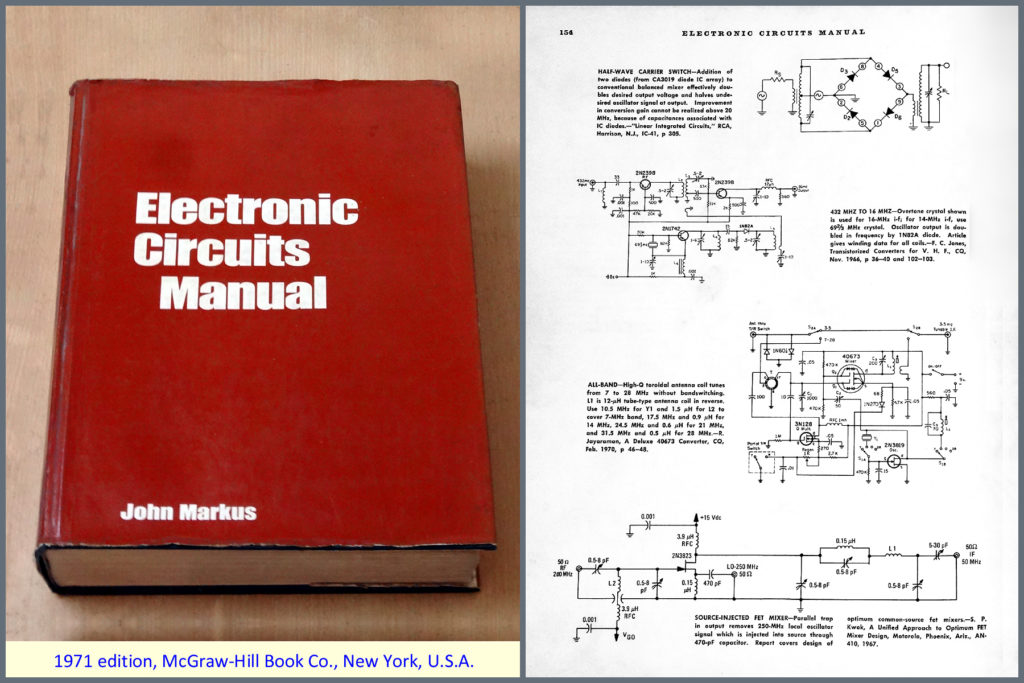 The 1971 edition of Electronic Circuits Manual (which had 3100 circuits in 988 pages) came out with the circuit of the 40673 Converter presented in my CQ article of Feb.1970. It was a satisfying moment for me.
The 1971 edition of Electronic Circuits Manual (which had 3100 circuits in 988 pages) came out with the circuit of the 40673 Converter presented in my CQ article of Feb.1970. It was a satisfying moment for me.
My association with W3MSK/ VU2MSK/ W3AU:
I first met Ed Bissell, W3MSK, in 1967, although I was having regular CW QSOs with him since 1965. He was working as an Engineer with NASA in USA, and had come to assist in setting up some facilities at the Thumba Equatorial Rocket Launching Station near Trivandrum. Ed was a keen DXer, and a member of the famous Potomac River Valley Amateur Radio Club in USA. Within a week of his arrival, Ed got his VU2MSK call-sign. He started working DX stations using a Collins KWM-2 rig from his room in Mascot Hotel which was just 2 km away from my house.
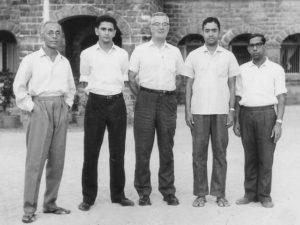
VU2BY (Karan), VU2VK (Kuki), W3MSK/VU2MSK (Ed Bissell), VU2JN (Jayaram) and VU2LN (Neel) at get-together in Trivandrum, 1967… Karan (aka Karunakaran) was the seniormost ham of Kerala.
Ed would visit me often, and take lunch or dinner with me, relishing the “drumstick sambar, aviyal and paal paayasam” (South Indian vegetarian dishes) prepared by my wife. Ed and I struck good rapport. So much so, once when I dropped a screw spanner, Ed chided me and said, “J’ram, mind your tools… never drop them. Back home, I climb my 120-foot antenna tower all by myself, wearing a safety belt. If I drop a tool after reaching the top that would be the end of the day’s work!”
I needed hard-to-get components for my projects, and Ed helped me with components such as crystals, transistors and good coaxial cable. It was from Ed that I learnt about the superiority of the silver-plated and double-braided RG223-U over RG58-U, and likewise, that of RG214-U over RG213-U and RG8-U.
Ed visited India again in 1970. By then, Ed had got his 4-letter call-sign W3AU. This time he brought me a Gotham 4-element 20-metre monoband beam, for which I insisted on his accepting a cheque for 120 dollars that I had received from CQ magazine. Ed, being a well-to-do NASA engineer, must have felt amused by my prudishness! With Ed’s help, I raised the big beam. It provided a forward gain of 9 db and a F/B ratio of 33 db. For just about 1 year, I had a hectic time operating my station using the beam fed by my 3×1625 PA. On some days, US stations reported that mine was the strongest CW signal from Asia in USA.
In 1971, I had to dismantle the beam in order to pursue my doctoral studies in the I.I.T., Madras. This time-tested beam is now lying with Venu (VU2MV) in Coimbatore, who used it for a short period while he was posted in New Delhi.
Contest operation:
During the period 1969 to 1985, I participated in the CW category of ARRL, CQ and other WW (World-wide) DX contests. In quite a few of these contests, I was the top-scoring VU ham. A few of my Contest certificates are shown below.
Now, with the integration of the PC and digital transceivers, contest operation has gone high-tech, more so for CW contests. Calling CQ, giving reports (always 599!) and logging are all managed by the PC. Yet, we have to make matching split-second keystrokes. It was so tough that I bade “Goodbye!” to contest operation!
A short trip to USA:
In 1976, I accompanied a relative of mine on a 1-month trip to USA. Though we were on a shoe-string budget, I managed to visit 2 US hams. One was Ed Bissell (W3AU) who was living in Accokeek near Washington.
Ed’s house was in a 1-acre plot in which stood 5 towers taller than 100 ft., carrying separate beam antennas for 80/40/20/15/10 metres! His shack had separate 1 KW linears for the 5 bands. The shack was specifically set up for ‘Multi-multi’ (Multi-transmitter multi-operator) contest operation. Oh, what a shack it was!
I felt happy when a smiling Ed pointed his fingers at the small, homebrew IC Keyer that I had presented to him in 1970, and said, “J’ram, I am still using that keyer!” The fully-shielded keyer was housed in a small rosewood cabinet with a sky-blue formica front-panel.
One more ham whom I was keen on visiting was Marv Gonsior (W6VFR, later W6FR) in Fullerton, Calif., with whom too I was having regular QSOs on 20 metres. In those days, Marv put out the strongest US signal on 20 metres in Trivandrum. Unfortunately, a trip to the west coast of USA was beyond the scope of my budget! Some time after the year 2000, Marv gave away all his ham equipment. Thereafter I lost touch with him.
Two close friends depart:
My local ham friend Kutty (VU2PKK) and myself continued to have regular SSB/CW QSOs with Ed Bissell on 20 metres, even after his health started declining by the turn of the century. And, in 2003, Ed passed away at the age of 83 years. It was a grievous loss for Kutty and me.
A few months later, the most touching incident of my ham career took place. I received an unsolicited gift from Ed’s wife — a FT-840 transceiver in good working condition. Mrs. Bissell informed me that it was one of Ed’s last wishes that one of his rigs should be sent to me. On reading her message, my eyes became moist.
Kutty’s health also started declining, but we continued to have regular QSOs on 40 metres. Kutty also continued to have DX QSOs on 20 metres with US ham friends like K3ZO (Fred) and W6CCP (Seymore). Sadly, Kutty passed away in 2012, aged 84 years.
The CET Amateur Radio Club (ARC):
Prior to the nineteen eighties, only a few of the graduates of the College of Engineering, Trivandrum became hams. They are: the late Kumar (VU2MKS), the late Neel (VU2LN), Booth (VU2BTH), Jayaram (VU2JN), and Nath (VU2PRV). Booth is not an active ham now. Nath, now in his seventies, is settled in Thrissur and is an active ham and homebrewer.
It was during the period 1984-87 that the Trivandrum Engineering College Amateur Radio Club was set up with the call-sign VU2TEC. While I functioned as the faculty-in-charge, Salim (VU2LID) of the 1985 B.Tech. batch was the technical adviser of the club, and Venu (VU2MV) of the 1987 batch was the go-getter secretary. The club was very active, and produced many hams like Madhu (VU2TEA) and his future spouse Mini (VU2TEN), Joseph (VU2TEJ), Rafeeque (VU2TEL), Roy (VU2TER), Sunil (VU2TES) and Fermi (VU2TEW).
The college had an old Racal receiver, to which the club members added a Crystal-controlled FET Converter. A 150-watt CW/AM transmitter & VFO were constructed. A novel feature of the VFO, which was in a separate cabinet, was that the DC supply for the VFO came from the transmitter through the VFO output cable, and switching the VFO from Standby to Transmit was accomplished by changing this supply voltage from 12 to 15 volts by the Receive/Transmit relay. Circuit-diagrams of the transmitter and VFO are linked at the end of this page, along with other articles.
Since the college is situated on the top of a hill overlooking the Arabian Sea, propagation conditions were excellent. The club boys worked thousands of DX stations, including hundreds of US stations. VU2TEC participated in the 1986 CQ WW CW contest, and came as the top-scoring station from India. Most members of CET ARC turned out to be good CW operators.
With the passing out of Venu’s batch, and with my leaving the college on promotion, VU2TEC went into hibernation. As is the fate of most Amateur Radio Clubs in the colleges of India, VU2TEC also became silent, after a few years of active operation. Now, attempts are being made to revive the CET ARC.
Salim took his Ph.D. in Structural Analysis, and is now employed in U.S.A. He has acquired the US call-sign N8LI, with which he operates from his Rhode Island QTH. Salim also comes on the air with the call-sign VU2LID from a remote station he has set up at his home QTH in Trivandrum. Venu, VU2MV, is working as Group Captain in the Indian Air Force, and is now stationed in Coimbatore.
Some CW stalwarts whom I have met and admired:
Menon (VU2KZ) was a temperamental CW enthusiast of Chennai who worked as a maritime wireless operator. I have heard him reprimanding hams who avoided CW! Sadly, he was killed by robbers in his house. Ganesh (VU2TS), who has distinguished himself in many fields like ham radio, astronomy, farming and bird-watching, is an old-timer settled in BR Hills near Bangalore. He is a keen CW operator with whom I used to have frequent QSOs. Ganesh is now the editor of Ham Radio News, the online magazine of ARSI. Saif (VU2DX), a retired engineer now settled in Pollachi, is equally at ease on CW and SSB modes. His enthusiasm for visiting hams and making friends is as deep as his love for ham radio operation!
Some recent Homebrew projects:
As I attained the age of 75 years, I found it increasingly tough to take up homebrewing projects not only due to gradual decline in stamina, but also due to mild tremor in fingers and loss of acuity of vision that rendered delicate soldering a ‘hit and miss’ job! However, my mind continued to dream of homebrew projects, albeit smaller ones! I remember a ham friend once telling me jokingly: “Jayaram, we need seven births to complete all the amateur radio projects that are bubbling in our mind!” Some of the recent projects that saw the light of the day are:
1. Frimatch ATU (Antenna Tuning Unit) — 2011.
PDF file attached.
2. ATU with Reflectometer: — 2011.
PDF file attached.
3. K20 CW Keyer — 2016.
4. 8-Digit Frequency Counter — 2016.
A few more of my homebrew projects are lying unfinished, awaiting redemption!
The 7033 Chat Circle:
It was during the nineteen seventies that the morning round-table on 7035 KHz AM was started by VU2LN, VU2TG and myself. VU2PKK joined the group after he joined ISRO and moved to Trivandrum. It was an active group with several members, and the topics of discussion were usually technical. As SSB nudged out AM for voice operation, we changed over to the SSB mode.
Some time after the year 2000, the chat frequency was changed to 7033 KHz to avoid some interference. We meet every day at 7.20 am Indian Standard Time, and continue upto 7.50 am.
Lifetime Achievement Award:
In January 2017, the Amateur Radio Society of India presented me a memento plaque in appreciation of the contributions to Amateur Radio in India. As an aging ham, I am thankful to the members of ARSI for bestowing this honour on me.
Homebrewing is flourishing!
Homebrewing skill is not essential for a ham, but it does enhance the satisfaction that amateur radio hobby gives. The positive response from youngsters to the construction workshops of the pioneer Dev (VU2DEV) proves that homebrewing is flourishing.
Among the senior hams whom I contact regularly now, Nath (VU2PRV) and Thyagu (VU2PTR) are keen homebrewers. Jam (VU2RQ) has not only been an active homebrewer, but has also rendered yeoman service to homebrewing by preparing a compendium CD of useful construction articles from all leading ham magazines.
Nath has recently fabricated a solid-state transceiver employing the famous Eddystone dial, and a linear employing 6146B tubes. His shack photo is appended below.
During recent trips that I made to Chennai, Thyagu (VU2PTR) was kind enough to take me to his home on the outskirts of Chennai, and showed me several of his homebrew gadgets which were as neatly constructed as good commercial equipment. His shack photo is appended below.
Thyagu also took me to the home of Venkat (VU2SV), where we had an absorbing chat. We noted that, even in the present age of increasingly complex commercial equipment, homebrewing is still relevant.
OM – Old Man, a short film:
In 2016, a short film entitled OM – Old Man was produced by my daughter Geetha and directed by her husband Ian McDonald, who are both faculty members in Newcastle University, U.K. Old Man was premiered at Film Festivals in Paris, New York and Chicago.
Old Man is basically a ‘wellness story’ woven around me, showing how an old man leads an active life, aided by his involvement in a hobby.
A recent Get-together:
During my recent visit to Chennai in June 2017, Thyagu (VU2PTR) arranged a get-together of interested hams at the flat in Mylapore where I was staying. It was an enjoyable get-together. Gopal Madhavan (VU2GMN, president of ARSI), Venkat (VU2SV, a senior ham), Thyagu (VU2PTR, an active homebrewer), Aiyna (VU2INA), Sekhar (VU2RDX) and Ravi (VU2ETO) enlivened the occasion by their presence. The group photo taken on that occasion is appended below.
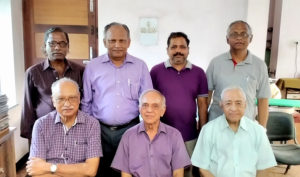
Ham meet in Chennai, June 2017 — Sitting (L to R): Gopal (VU2GMN), Venkat (VU2SV), Jayaram (VU2JN). Standing (L to R): Aiyna (VU2INA), Thyagu (VU2PTR), Ravi (VU2ETO), Sekhar (VU2RDX).
Ham Radio articles authored by me:
Some of the articles relating to Ham Radio, authored by me, are:
US magazines:
- QST (publication of ARRL, the American Radio Relay League):
- A Transistor Transmitter from India — QST, Nov. 1967.
- The Transistor Giant — QST, Oct. 1969.
- Deluxe Code Reception, VU2 Style! — QST, Feb. 1972.
- CQ magazine:
- An Improved 7360 Converter — CQ, Jun. 1969.
- Deluxe 40673 Converter — CQ, Feb. 1970.
- Delayed Switching for Transistor Receivers — CQ, Feb. 1970.
- The Blink-O-Nil — CQ, Jul. 1972.
- The Gigohmer — CQ, Apr. 1973.
- Deluxe Screen Modulator — CQ, Aug. 1973.
- 73 magazine:
- Deluxe Receiver Gain Control — 73, Sep. 1970.
The Indian Radio Amateur (publication of ARSI, Amateur Radio Society of India, later transformed to the online newsletter Ham Radio News):
- A Miniwatt Transistor Transmitter — IRA, Dec. 1966.
- 7 MHz VFO — IRA, Feb.-Apr. 1967.
- The Mighty Midget — IRA, Oct. 1967.
- IC Keyer — IRA, Feb. 1970.
- Frimatch ATU — HRN, Mar. 2011.
- ATU with Reflectometer — HRN, Apr. 2011.
- Brief Notes on Toroid Characteristics — HRN, Feb. 2013.
- Cockroft-Walton Voltage Multiplier — HRN, Mar. 2013.
( I have authored some more articles in the IRA.)
Other Items and Online Uploads:
- A Stable 7 MHz VFO — Souvenir of Amateur Radio Convention, Madras (Chennai), 1976.
- Transmitter circuit at ARC of CET — 1985.
- VFO circuit at ARC of CET — 1985.
- Faded Dream — a poem, Nov. 2005.
- A Trip down Memory Lane — Souvenir of Amateur Radio Convention, Chennai, 2012.

